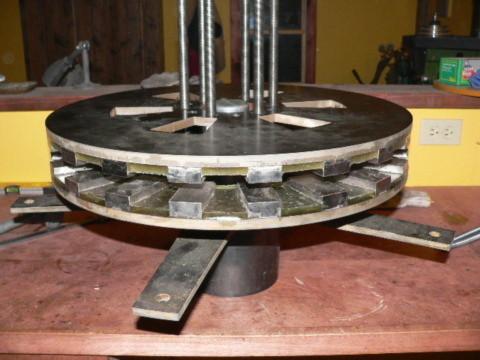Hi brandnewb,
After your many requests for help, I'll agree to help you with the design of the alternator for your Phoenix VAWT.
I have read many of the posts on the diysolarforum, where you started your journey to build the 'sickest VAWT' over 2 years ago.
From the beginning, there were some users there and on this Forum that gave you good and sound advice. It is possible that you could not grasp what they were telling you. That is probably why you chose to continue to do it your way, even without a clear understanding of some of the simplest electrical terms and without an understanding of electromagnetism. It takes time and a lot of effort to learn that stuff.
At least you have perseverance and enthusiasm, that is good and commendable, but as I told you in the IM's, it will only help you if you have goals and stay focused.
I don't know how successful I will be in getting you back on the road, but I am going to give it a shot.
You have said many times that you want to do some tests that will help this Forum. So I am going to suggest some useful tests that you can do that will be helpful to us here and will help you acquire good data for your future BIG alternator.
I will start with this statement; you cannot get useful data by doing tests with the coils and magnets that you are using now, and I'll tell you why.
The magnets that you are using are too small and they have the wrong proportions of length to width, and they are too thin. Nobody will ever seriously think about using magnets like that to build an alternator. So, any tests that you do with those magnets are not useful when it comes to building an alternator.
When you asked about stacking magnets, Adriaan wrote this:
"However, if the total magnet thickness is about the same as the total air gap thickness, you can better keep it as it is"I think that you missed that. What Adriaan said is that the ideal air gap for your 5mm thick magnets is 5mm. The 3 overlapping coils that you have are about 30mm thick? At 30mm, the flux reaching the coil will be less than 15%. You need thicker and wider magnets.
The coils that you are using now are useless for any type of alternator. The wire is too thin and with too many turns. That makes the resistance way too high.
This equation, P = (I^2) x R is used to find the power dissipated by a resistor in watts.
Remember this, when you build an alternator and you wire all the coils, the finished alternator becomes a large resistor.
Most of the alternators that are built by some of the members here have coils with resistance of .5 ohms or less. The resistance of your coils is about 9 ohms per coil.
P = (I^2) x R
P = power in Watts
I= Current in Amps
R= Resistance in Ohms
Example:If resistance of one coil is .5 ohms, 3 coils in series is 1.5 ohms.
Assume that the current is 15 amps and voltage is 58 volts.
Total alternator power = 870 watts
P=(15x15) x 1.5 = 337 watts dissipated as heat in the stator.
Now let’s see how much power will be dissipated with 3 of your 9 ohms coils.
P=(15x15) x 27 = 6,075 watts (HEAT) dissipated in the stator.
That will not be called an alternator. It will be a copper smelter.
The bottom line, you need to keep coil resistance at .5 ohms or less.
The only way to do that is to use less turns and use at least 1mm wire for the coils.
If you can build a good testing platform with 2 rotors similar to this, it will help a lot:

It doesn’t have to be that big, 8 or 12 magnets per rotor should be OK.
You already have a Variable Frequency Drive. All you would need is a 2 HP 3-phase electric motor for turning the rotors at different speeds. Or you can use your Variac to turn a DC motor. The DC motor might be a better choice because the VFD's have a hard time running at very low RPM.
With that setup you can test different coils with different air gaps at different speeds and do other tests to get useful data that could also be of value to Forum members.
If you are interested in building the testing platform, let me know and I can help you with that.
Don't expect to get an electrical or electromagnetism education from Forums. We all learn mostly by doing and building things.
When you can sit in your warm home and look out the window and see the Phoenix spinning and making watts, then you will notice that you have learned quite a lot. And if you stay focused, that could be soon.
Ed